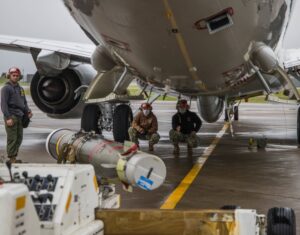The Department of Defense’s Office of the Inspector General (DoD IG) publicly released an audit of the Navy’s P-8A Poseidon fleet, finding its mission capable rates were below the 80 percent requirement.
The audit sought to determine whether the Navy’s Poseidons meet the anti-submarine warfare requirements of U.S. European Command (EUCOM).
The Poseidons are primarily used by theater commanders for anti-submarine warfare (ASW) operations and EUCOM specifically deals with a Russian naval force operating both attack submarines and ballistic missile submarines. The report said that according to the Defense Intelligence Agency, Russia’s Northern Fleet, which is within the EUCOM Area of Responsibility (AOR), is Russia’s most capable naval force.
The report said U.S. Naval Forces Europe-Africa/U.S. Sixth Fleet Deputy Commander for Theater Undersea Warfare stated while the U.S. deploys various assets for ASW operations in the region, the P-8A is the Navy’s “primary air asset to effectively counter Russia’s most technologically advanced submarines.”

The DoD IG first announced it will start evaluating the P-8As last year (Defense Daily, April 14, 2020). The report is dated May 19 and was released on May 21.
The report noted a Naval Air Forces instruction that all Navy squadrons maintain a mission capable rate of 80 percent, but from October 2018 through March 2020 the service’s mission capable rates of the Poseidon fleet ranged from 53 to 70 percent. This means at the time, the P-8A fleet did not meet the EUCOM contingency requirement of 77 mission capable P-8As.
The Navy deployed an average of seven Poseidons to Naval Air Station (NAS) Sigonella, Italy on six-month rotations during this period. NAS Sigonella is the primary deployment site for the Poseidons in the EUCOM AOR.
This report comes as the Navy is in the process of transitioning from the legacy P-3 Orion to the P-8A for the multi-mission maritime patrol and reconnaissance aircraft role. The Navy plans to finish transitioning the fleet in fiscal year 2022 and until then is using a mix of both aircraft.
The report noted as of October 2020 the Navy’s inventory consists of nine Orions and 104 Poseidons assigned to Maritime Patrol Reconnaissance Aircraft (MPRA) squadrons.
The IG said Poseidon fleet sustainment problems included maintenance personnel experiencing delays in identifying and receiving spare parts; MPRA Program Office and Naval Supply Systems Command (NAVSUP) Weapon Systems Support personnel did not provide maintenance personnel with detailed maintenance procedures and technical data for the aircraft’s mission-specific systems and equipment; and P-8A squadrons had consumable spare part shortages like O rings, valve assemblies, bolts and rivets while deployed in the EUCOM AOR.
The report said this low mission capability happened because the MPRA Program Office and Program Executive Office for Air Anti-Submarine Warfare, Assault and Special Mission Programs, also called PEO(A), “did not develop a supportable sustainment strategy for the P-8A Poseidon fleet.”
“Also, the PEO(A) officials did not oversee the MPRA Program Office personnel’s implementation of corrective actions to address sustainment challenges identified in P-8A independent logistics assessments,” in accordance with Secretary of the Navy instructions, the report added.
The report argued Navy officials also did not require the MPRA Program Office to conduct a five-year sustainment review, in accordance with the U.S. Code, and both the MPRA Program Office and NAVSUP personnel “did not provide sufficient on-hand stocks of P-8A Poseidon consumable spare parts” to meet EUCOM’s demand.
“MPRA’s implementation of an incomplete sustainment strategy and program along with a lack of oversight by the PEO(A) throughout the P-8A lifecycle led to sustainment problems that further contributed to the P-8A Poseidon’s low mission capability rate,” the report said.
The IG recommended the MPRA Program Manager coordinate with the Commander of NAVSUP Weapon Systems Support and the Naval Air Systems Command P-8A Poseidon Fleet Support Team Engineering and Logistics Leads to “develop and implement a plan to address sustainment challenges of the P-8A Poseidon Fleet.”
It also recommended that the Commander of Naval Supply Systems Command Weapon Systems Support coordinate with the MPRA Program Manager to develop and implement a “demand forecast for P-8A Poseidon consumable spare parts” in the EUCOM AOR.
The report recommended two measures for PEO(A): develop and implement a plan of action and milestones to correct and monitor sustainment deficiencies in the Poseidon program in coordination with the MPRA Program Office, as well as conduct a review of the PMRA Program office’s processes and procedures to determine whether critical sustainment analyses are conducted and to improve internal controls of the P-8A sustainment strategy.
The last DoD IG recommendation was that the Deputy Assistant Secretary of the Navy for Sustainment direct the MPRA Program Manager conduct five-year sustainment reviews for the P-8As.
According to the report, the MPRA program manager agreed to “develop a plan to address the incomplete provisioning of P-8A Poseidon parts and the lack of P-8A Poseidon technical data. That recommendation is resolved but still remains open. Meanwhile, the NAVSUP Weapons Support Commander addressed P-8A consumable parts at NAS Sigonella, allowing that recommendation to be closed.
PEO(A) agreed to develop plans of action and milestones to correct, monitor and validate P-8A sustainment deficiencies as well as review processes for critical sustainment analyses and improving internal controls. DoD IG considers the recommendation resolved by still open,
Finally, the Deputy Assistant Secretary of the Navy for Sustainment \“addressed our recommendation to conduct a P-8A Poseidon sustainment review,” the IG said. That matter is resolved but still remains open.
The recommendations are considered resolved when management agrees to implement the office’s measures or proposed actions to address the underlying findings. Recommendations are then closed when the Office of the IG has “verified that the agreed upon corrective actions were implemented.”